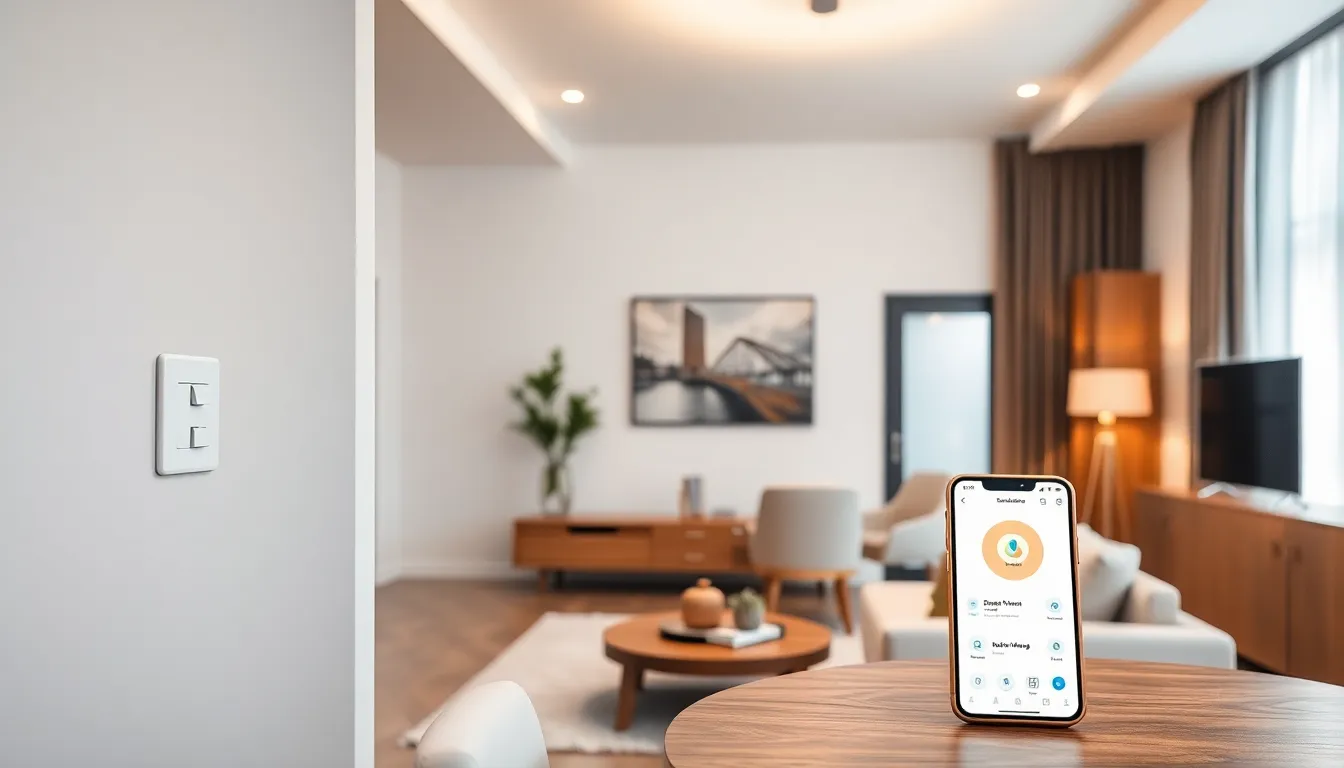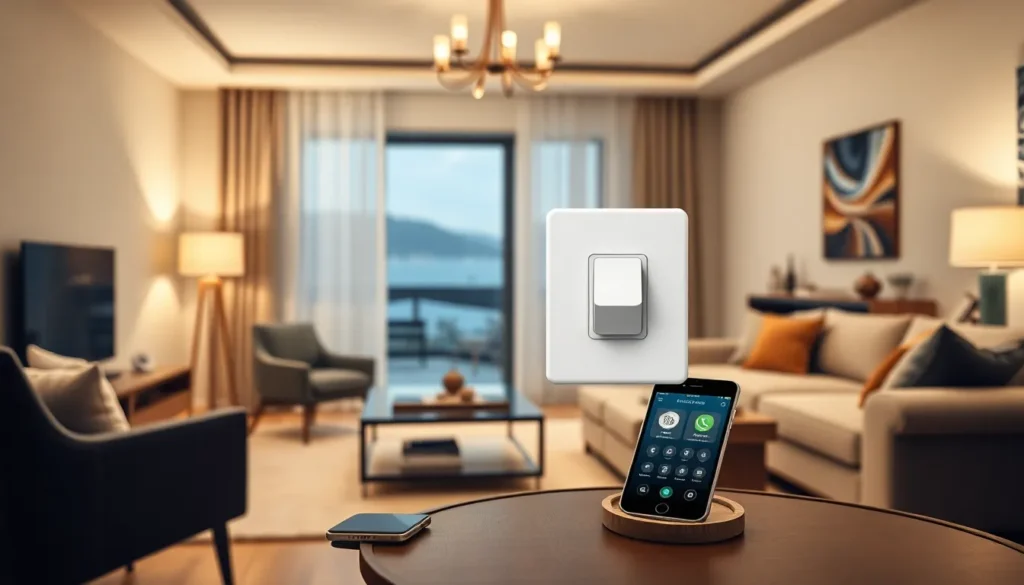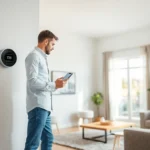Imagine walking into your home and instantly transforming it into a scene from a sci-fi movie. With a smart home switch, that dream’s just a flick away. Gone are the days of fumbling for light switches or arguing over who left the lights on. These nifty gadgets let you control your home’s ambiance with just a tap on your smartphone or a simple voice command.
Not only do smart switches add a sprinkle of convenience, but they also bring a touch of elegance to your space. Think of them as the stylish butlers of your home, ready to cater to your every lighting whim. Whether it’s setting the mood for a romantic dinner or ensuring you never trip over the cat at night, smart home switches are here to make life a little brighter—and a lot smarter.
What Is a Smart Home Switch?
A smart home switch is a device that allows for remote control of electrical appliances, primarily lighting, within a home. These switches connect to a home’s Wi-Fi network, granting users access to manage lights and other connected devices from smartphones, tablets, or smart speakers. Transforming conventional electrical systems, smart switches enhance convenience, safety, and energy efficiency.
Many smart home switches integrate seamlessly with smart home systems, including Amazon Alexa, Google Assistant, and Apple HomeKit. Users can issue voice commands for hands-free operation, simplifying daily routines. Compatibility across various platforms helps in personalizing user experiences.
Enhanced features often include scheduling options and remote access capabilities. Scheduling allows users to set specific times for lights to turn on or off, catering to varied needs. Remote access, on the other hand, enables monitoring and control, promoting energy savings when away from home.
Installation processes vary, with some smart switches requiring neutral wires for operation. Others work as plug-and-play devices, appealing to renters or those hesitant to alter existing wiring. Selecting an appropriate switch depends on installation preferences and compatibility with current home ecosystems.
Overall, smart home switches represent a significant advancement in residential technology. These devices enhance not only control over lighting but also contribute to a more efficient and stylish living environment. Embracing this innovation transforms ordinary spaces into smart homes.
Benefits of Smart Home Switches

Smart home switches offer numerous advantages that enhance the living experience. These devices not only simplify everyday tasks, but they also contribute to a more sustainable lifestyle.
Enhanced Convenience
Convenience ranks high among the benefits of smart home switches. Users can control lighting from anywhere using smartphones or tablets. Voice command compatibility with systems like Amazon Alexa and Google Assistant allows effortless operation. Scheduling features enable users to set specific times for lights to turn on or off, improving daily routines. Additionally, remote access provides peace of mind, as users can turn lights on while away for security. No more fumbling for manual switches in the dark makes evenings more enjoyable.
Energy Efficiency
Energy efficiency significantly improves with smart home switches. These devices allow users to monitor energy consumption, promoting informed decisions. Scheduling lights to align with natural daylight reduces unnecessary usage. Moreover, the ability to turn off lights remotely prevents leaving them on inadvertently. Many smart switches provide usage statistics, helping users pinpoint habits that waste energy. With these savings, residents not only lower their utility bills but also contribute to a more eco-friendly home.
Types of Smart Home Switches
Smart home switches come in various types, each designed to enhance functionality in unique ways. Understanding these types helps users choose the right one for specific needs.
Smart Light Switches
Smart light switches connect directly to the home’s Wi-Fi, allowing control of lights remotely. Users can operate them through smartphone apps or voice commands via platforms like Amazon Alexa or Google Assistant. These switches often include features such as dimming options and programmable schedules. For example, setting lights to gradually brighten in the morning creates a natural wake-up experience. Compatibility with existing wiring varies, with options available for homes without neutral wires. Enhanced security features let users simulate occupancy by scheduling lights to turn on and off when they are away.
Smart Plugs and Outlets
Smart plugs and outlets extend the benefits of smart home technology beyond lighting. These devices plug into standard outlets and transform ordinary appliances into smart ones. Users can control devices like lamps, fans, or coffee makers from their smartphones. Many smart plugs offer energy monitoring capabilities, providing insights into power consumption. These insights support users in managing energy usage effectively. Scheduling functions allow devices to operate on a predetermined timetable, making daily routines smoother. Furthermore, smart plugs integrate seamlessly with voice-activated systems, adding convenience to households.
How to Choose the Right Smart Home Switch
Determining the right smart home switch involves several key factors. Consider compatibility first. Ensure the switch integrates seamlessly with existing smart home systems like Amazon Alexa, Google Assistant, or Apple HomeKit. A compatible device provides greater flexibility and enhances user experience.
Next, evaluate the installation requirements. Some switches need neutral wires, while others are plug-and-play. Those requiring minimal wiring work well for renters or individuals hesitant about significant home modifications. Assessing these needs can simplify the selection process considerably.
Look into features as well. Advanced options include remote capabilities and scheduling. These functions enhance convenience and provide energy savings. By allowing users to set specific times for lights to turn on or off, smart switches contribute to a sustainable lifestyle.
Pricing also plays a crucial role in the selection process. Numerous options exist across various price points. Evaluating budget constraints helps narrow choices effectively without compromising essential features.
Reliability is another important consideration. Reading user reviews provides insights into performance and durability. Evaluating feedback can guide choices toward well-reviewed switches that offer optimal reliability.
Lastly, factor in design. Aesthetics matter, especially since smart switches enhance home decor. Opt for a design that complements the existing style and adds elegance to the environment. Selecting a visually appealing switch creates a cohesive look in any room.
By focusing on compatibility, installation, features, pricing, reliability, and design, individuals can confidently choose the ideal smart home switch for their needs.
Installation and Setup
Proper installation and setup of a smart home switch enhance functionality. Understanding the methods ensures optimal performance and user satisfaction.
Wireless vs. Wired Installation
Wireless installation simplifies setup significantly. These switches connect through Wi-Fi, not requiring extensive wiring, making them ideal for renters. Wireless options often come with easy-to-follow instructions, allowing for quick installation. Wired switches, however, may need a neutral wire and involve more complex procedures. These options often provide enhanced reliability and speed in communication. Individuals with existing wiring may prefer wired setups for better integration with current systems. Choosing between these two methods depends on home configurations and user preferences.
Compatibility with Smart Home Systems
Compatibility with smart home systems plays a crucial role in user experience. Smart switches typically support platforms like Amazon Alexa, Google Assistant, and Apple HomeKit. Ensuring compatibility allows for seamless voice control and automation features. Buyers should verify specifications to confirm integration with their existing devices. Compatibility expands possibilities for creating routines and managing multiple devices from one app. Prioritizing this compatibility guarantees the switch enhances overall smart home functionality. Users achieve greater control and efficiency through proper integration into their ecosystems.
Smart home switches are revolutionizing how people interact with their living spaces. By offering convenience elegance and energy efficiency they elevate everyday routines. With features like remote access and voice control these devices not only simplify home management but also contribute to a sustainable lifestyle.
Choosing the right smart home switch involves considering compatibility installation requirements and design. With the right choice homeowners can seamlessly integrate these devices into their lives enhancing both comfort and security. Embracing smart home technology is more than a trend; it’s a step toward a more efficient and enjoyable living environment.













